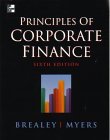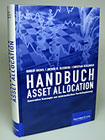 |
| Literaturverzeichnis |
| |
|
 |
 |
 |
Alle mit Bildern ausgestatteten Literaturquellen
führen Sie direkt zum jeweiligen Buch bei amazon.de. |
Abel, Andrew B. (1990): Asset prices under habit formation
and catching up
with the Joneses, in: American Economic Review 80, S.38-42.
Arnott, Robert D. (2003): Ethics,
Earnings and Equity Valuation, in: The Journal
of Portfoliomanagement (Spring 2003), S.8-16.
Arnott, Robert D. und Asness, Clifford S. (2003): Surprise!
Higher Dividends
= Higher Earnings Growth, in: Financial Analysts Journal (Jan/Feb
2003), S.70- 87.
Arnott, Robert D. und Bernstein, Peter L.
(2002): What Risk Premium Is
„Normal“?, in: Financial Analysts Journal (March/April
2002), S.64-85.
Arnott, Robert D. und Ryan, Ronald J. (2001): The Death of
the Risk Premium,
in: The Journal of Portfolio Management (Spring 2001), S.61-74.
Barsky, Robert B., Kimball, Miles S., Juster,
Thomas F. und Shapiro, Matthew D.
(1997): Preference Parameters and Behavioral Heterogeneity:
An Experimental
Approach in the Health and Retirement Study, in: Quarterly Journal
of Economics
112 (May 1997), S. 537-579.
Benartzi, Shlomo und Thaler, Richard (1995):
Myopic Loss Aversion and the
Equity Premium Puzzle, in: Quarterly Journal of Economics, vol.110(1),
S.73-92.
Best, Michael J. und Grauer, Robert R. (1991):
On the Sensitivity of Means-
Variance-Efficient Portfolios to Changes in Asset Means: Some Analytical
and
Computational Results, in: Review of Financial Studies, Volume 4
(2), S.315-
342.
Brinson, Gary P., Hood, Randolph L. und
Beebower, Gilbert L. (1986):
Determinants of Portfolio Preference, in: Financial Analysts Journal,
Volume
42(4), S. 39-44.
Brinson, Gary P., Hood, Randolph L. und
Beebower, Gilbert L. (1991):
Determinants of Portfolio Preference II: An Update, in: Financial
Analysts
Journal, Volume 47(3), S.40-48.
Black, Fischer und Litterman, Robert (1992):
Global Asset Allocation With
Equities, Bonds and Currencies. Working Paper, Goldman Sachs, October
1991.
Bollerslev, Tim (1986): Generalized
Autoregressive Conditional
Heteroskedasticity, in: Journal of Econometrics 31, S. 307-327.
Brown, Stephen J.,Goetzmann, William N.
und Ross, Stephen A (1995):
Survival, in: Journal of Finance 50, S.853 – 873.
Campbell, John Y. (1991): A Variance
Decomposition for Stock Returns, in:
Economic Journal 101, S. 157-179.
Campbell, John Y., Lo, Andrew W. und MacKinley,
Archie C. (1997): The
Econometrics of Financial Markets. Princeton University Press, Princeton
1997.
Claus, James und Thomas, Jacob (2001):
Equity Premia as Low as Three Percent?
Evidence from Analysts’ Earnings Forecasts for Domestic and
International Stock
Markets, in: The Journal of Finance Vol. LVI, no.5, S.1629-1666.
Chopra, Vijay K. und Ziemba, William T.
(1993): The Effect of Errors in Means,
Variances, and Covariances on Optimal Portfolio Choice, in: The
Journal of
Portfolio Management (1993), S. 53-61.
Cochrane, John H.(1997): Where is
the Market going? , in: Economic
Perspectives, Volume 21(6), S. 2-40.
Constantinides,George M. (1990):
Habit Formation: A Resolution of the Equity
Premium Puzzle. Journal of political Economy, Volume 98 (3), S.519-543.
Constantinides, George M., und Duffie, Darell (1996): Asset
Pricing with
Heterogeneous Consumers, in: Journal of Political Economy, Volume
CIV
(1996), S. 219-240.
Constantinides, George.M., Donaldson, John B., und Mehra, Rajnish
(2002):
Junior Can’t Borrow: A New Perspective on the Equity Premium
Puzzle, in:
Quarterly Journal of Economics, Volume 117 (Feb 2002), S.269-296.
Davis, Stephen J. und Willen, Paul (2000):
Using Financial Assets to Hedge
Labor Income Risk: Estimating the Benefits. Working paper, University
of
Chicago 2000.
Drobetz, Wolfgang (2000): Wie hoch
ist die Risikoprämie am Schweizer
Aktienmarkt?, in: Finanzmarkt und Portfoliomanagement 12, S. 364-386.
Drobetz, Wolfgang (2002a): Historical
returns and the equity premium puzzle.
Working Paper, St. Gallen, April 2002.
Drobetz, Wolfgang (2002b): Einsatz
des Black-Litterman Verfahrens in der Asset
Allocation. Working Paper No. 3/ 02, WWZ Basel/ Department of Finance.
Duesenberry, James S. (1949): Income,
Saving and the Theory of Consumer
Behavior. Harvard University Press, Cambridge 1949.
Enderle, Francis J., Pope, Brad und Siegel,
Laurence B. (2003): Broad-
Capitalization Indexes of the U.S. Equity Market, in: The Journal
of Investing
(Spring 2003), Volume 12(1), S.11-22.
Engle, Robert F. (1993): Statistical
Models for Financial Volatility, in: Financial
Analysts Journal (Jan/Feb 1993), S.72-78.
Epstein,Larry G. und Zin, Stanley E. (1989):
Substitution, Risk Aversion, and the
Temporal Behavior of Consumption Growth and Asset Returns I: A Theoretical
Framework, in: Econometrica, Volume 57(4), S. 937-969.
Feinman, Joshua N. (2002): What can
we expect for asset returns in the long run?,
in: The Journal of Investing, Volume 11(3), S. 66-76.
Ferson,Wayne E. und Constantinides, George
M. (1991): Habit Persistence and
Durability in Aggregate Consumption: Empirical Tests, in: Journal
of Financial
Economics (Oct 1991), S.199-240.
Friend, Irwin und Blume, Marshall (1975):
The Demand for Risky Assets, in:
American Economic Review (65), S. 900-922.
Gali, Jordi (1994): Keeping Up with
the Joneses: Consumption Exter-
nalities, Portfolio Choice, and Asset Prices, in: Journal of Money,
Credit and
Banking, Volume 26(1), S. 1-8.
Gebhardt, William R., Lee, Charles M.C.
und Swaminathan, Bhaskaran (2001):
Toward an Implied Cost of Capital, in: Journal of Accounting Research,
Volume
39 (1), S.135-176.
Glassman, James K. und Hasset, Kevin (1999): Dow 36000: The
New Strategy
for Profiting from the Coming Rise in the Stock Market. NY: Times
Books 1999.
Gordon, Myron J. (1962): The investment, financing and valuation
of the
corporation. Irwin Publishing, Homewood.
Gossen, Herrmann H. (1889): Entwicklung
der Gesetze des menschlichen
Verkehrs und der daraus fließenden Regeln für menschliches
Handeln. Berlin:
Prager.
Ibbotson Associates (2001): Stocks,
Bonds, Bills and Inflation: 2001 Yearbook.
Chicago 2001.
Ibbotson, Roger G. Und Chen, Peng (2003): Long-Run Stock
Returns:
Participating in the Real Economy, in: Financial Analysts Journal
(Jan/Feb 2003),
S.88-98.
Ilmanen, Antti (2003): Expected Returns
on Stocks and Bonds, in: The Journal of
Portolio Management (Winter 2003), S.7-27.
Jagannathan, Ravi, McGrattan, Ellen R. und
Scherbina, Anna (2000): The
Declining U.S. Equity Premium, in: Federal Reserve Bank of Minneapolis
Quarterly Review, Volume 24(4), S.3-19.
Kaiser, Helmut und Krämer, Werner (2003):
Muss man in diesen Zeiten noch
Aktien besitzen? , in: Die Bank, Februar 2003, S.82-88.
Kandel, Shmuel und Stambaugh, Robert F.
(1991): Asset Returns and
Intertemporal Preferences, in: Journal of Monetary Economics (27),
S.39-71.
Kocherlakota, Narayana (1996):
The Equity Premium: it's still a Puzzle, in:
Journal of Economic Literature, Volume 34(1), S.42-71.
Lee,Wai (2000): Advanced Theory
and Methodology of Tactical Asset
Allocation. McGraw-Hill Professional, July 2000.
Leibowitz, Martin L. u.a. (2001):
Equity Risk Premium Forum, AIMR, November
2001. Abrufdatum 1.Mai 2003 unter:
[http://aimrpubs.org/ap/issues/v2002n1/toc.html].
Litterman, Robert und Winkelmann, Kurt (1998): Estimating
Covariance
Matrices. Working Paper, Goldman Sachs, Januar 1998.
Mankiw, Gregory N. und Zeldes, Stephen
P. (1991): The Consumption of
Stockholders and Non-Stockholders, in: Journal of Financial Economics,
Volume
29, S. 97-112.
Markowitz, Harry M. (1952): Portfolio Selection, in: Journal
of Finance, Volume
7, S. 77-91.
McGrattan, Ellen R., und Prescott, Edward C. (2000): Is the
Market Overvalued?,
in: Federal Reserve Bank of Minneapolis Quarterly Review 24, S.
20–40.
McGrattan, Ellen R., und Prescott, Edward C. (2001): Taxes,
Regulations, and
Asset Prices. Working Paper, Federal Reserve Bank of Minneapolis
(July 2001).
Mehra, Rajnish (2003): The Equity
Premium: Why Is It A Puzzle? , in: Financial
Analyst Journal (Jan/Feb 2003), S.54-69.
Mehra, Rajnish und Prescott, Edward C. (1985):
The Equity Premium: A Puzzle,
in: Journal of Monetary Economics, Volume 15(2), S. 145-161.
Michaud, Richard O. (1989): The Markowitz Optimization Enigma:
Is
‘Optimized’ Optimal?, in: Financial Analysts Journal,
Jan/Feb 1989, S. 31-39.
Miller, Merton und Modigliani, Franco (1961):
Dividend Policy, Growth and the
Valuation of Shares, in: Journal of Business, Volume 34 (4), S.411-433.
Rietz, Thomas A.(1988): The Equity
Risk Premium: A Solution, in: Journal of
Monetary Economics (22), S. 117-131.
Schäfer, Klaus und Zimmermann, Peter
(1998): Portfolio Selection und
Schätzfehler bei den erwarteten Renditen: Ergebnisse für
den deutschen
Aktienmarkt, in: Finanzmarkt und Portfolio Management, Jahrgang
12 (2), S.
131-149.
Sharpe, Steven A. (2002): How Does
the Market Interpret Analysts´ Long-term
Growth Forecasts? Working Paper, Federal Reserve Board, Washington
D.C.
2002.
Sharpe, William F.(1963): A simplified
model for portfolio analysis, in:
Management Science (Jan 1963) S. 277-293.
Sharpe, William F.(1964): Capital
Asset Prices - A Theory of Market Equilibrium
Under Conditions of Risk, in: Journal of Finance (September 1964),
S. 425-442.
Sharpe, William F.(1966): Mutual
Fund Performance, in: Journal of Business (Jan
1966), S.119-138.
Siegel, Jeremmy J.(1999): The Shrinking
Equity Premium, in: The Journal of
Portfolio Management (Fall 1999), S.10-17.
Smith, Adam (1776): An Inquiry into
the Nature and Causes of the Wealth of
Nations. London 1776.
Thaler, Richard H. (1997): The effect
of myopia and loss aversion on risk taking:
An experimental test, in: The Quarterly Journal of Economics (May
1997), S.647-
661.
Tobin, James (1958): Liquidity Preference as Behaviour Towards
Risk, in:
Review of Economic Studies, Volume 25, S. 65-86.
Trevino, Ruben C. und Robertson, Fiona (2002):
P/E Ratios and Stock Market
Returns, in: Journal of Financial Planning (Feb 2002), S.76-84.
Tversky, Amos und Kahneman, Daniel (1992):
Advances in prospect theory:
Cumulative representation of uncertainty, in: Journal of Risk and
Uncertainty,
Volume 5, S. 297-323.
Weil, Philippe (1989): The Equity
Premium Puzzle and the Riskfree Rate Ruzzle,
in: Journal of Monetary Economics, Volume 24 (3), S. 401-422.
Welch, Ivo (2000): Views of Financial
Economists on the Equity Premium and on
Professional Controversies, in: Journal of Business, Volume 73 (4)
, S. 501-537.
|
 |
| Info |
|
|
|
 |
|

 Nach oben I Home
I Impressum
Nach oben I Home
I Impressum 








